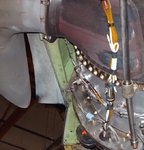Clay_Allison
Staff Sergeant
- 1,154
- Dec 24, 2008
I was thinking about (and reading threads about) various desperate German attempts to gain an edge in the skies that would keep the war from tipping violently against them. I was wondering why they never seemed to consider using a turboprop-driven fighter. A turbine engine could potentially deliver a big boost in power, provide additional thrust for more speed, and be incorporated into an existing fighter. I don't know enough to say, (that's why I'm asking) but a 2000 horsepower Bf-109 might be possible, and might just fly like a bat out of hell.



